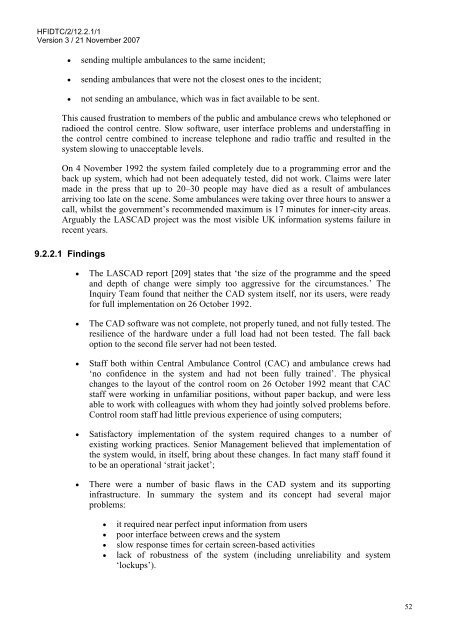The Impact of Technology Insertion on Organisations
The Impact of Technology Insertion on Organisations
The Impact of Technology Insertion on Organisations
Create successful ePaper yourself
Turn your PDF publications into a flip-book with our unique Google optimized e-Paper software.
HFIDTC/2/12.2.1/1<br />
Versi<strong>on</strong> 3 / 21 November 2007<br />
• sending multiple ambulances to the same incident;<br />
• sending ambulances that were not the closest <strong>on</strong>es to the incident;<br />
• not sending an ambulance, which was in fact available to be sent.<br />
This caused frustrati<strong>on</strong> to members <str<strong>on</strong>g>of</str<strong>on</strong>g> the public and ambulance crews who teleph<strong>on</strong>ed or<br />
radioed the c<strong>on</strong>trol centre. Slow s<str<strong>on</strong>g>of</str<strong>on</strong>g>tware, user interface problems and understaffing in<br />
the c<strong>on</strong>trol centre combined to increase teleph<strong>on</strong>e and radio traffic and resulted in the<br />
system slowing to unacceptable levels.<br />
On 4 November 1992 the system failed completely due to a programming error and the<br />
back up system, which had not been adequately tested, did not work. Claims were later<br />
made in the press that up to 20–30 people may have died as a result <str<strong>on</strong>g>of</str<strong>on</strong>g> ambulances<br />
arriving too late <strong>on</strong> the scene. Some ambulances were taking over three hours to answer a<br />
call, whilst the government’s recommended maximum is 17 minutes for inner-city areas.<br />
Arguably the LASCAD project was the most visible UK informati<strong>on</strong> systems failure in<br />
recent years.<br />
9.2.2.1 Findings<br />
• <str<strong>on</strong>g>The</str<strong>on</strong>g> LASCAD report [209] states that ‘the size <str<strong>on</strong>g>of</str<strong>on</strong>g> the programme and the speed<br />
and depth <str<strong>on</strong>g>of</str<strong>on</strong>g> change were simply too aggressive for the circumstances.’ <str<strong>on</strong>g>The</str<strong>on</strong>g><br />
Inquiry Team found that neither the CAD system itself, nor its users, were ready<br />
for full implementati<strong>on</strong> <strong>on</strong> 26 October 1992.<br />
• <str<strong>on</strong>g>The</str<strong>on</strong>g> CAD s<str<strong>on</strong>g>of</str<strong>on</strong>g>tware was not complete, not properly tuned, and not fully tested. <str<strong>on</strong>g>The</str<strong>on</strong>g><br />
resilience <str<strong>on</strong>g>of</str<strong>on</strong>g> the hardware under a full load had not been tested. <str<strong>on</strong>g>The</str<strong>on</strong>g> fall back<br />
opti<strong>on</strong> to the sec<strong>on</strong>d file server had not been tested.<br />
• Staff both within Central Ambulance C<strong>on</strong>trol (CAC) and ambulance crews had<br />
‘no c<strong>on</strong>fidence in the system and had not been fully trained’. <str<strong>on</strong>g>The</str<strong>on</strong>g> physical<br />
changes to the layout <str<strong>on</strong>g>of</str<strong>on</strong>g> the c<strong>on</strong>trol room <strong>on</strong> 26 October 1992 meant that CAC<br />
staff were working in unfamiliar positi<strong>on</strong>s, without paper backup, and were less<br />
able to work with colleagues with whom they had jointly solved problems before.<br />
C<strong>on</strong>trol room staff had little previous experience <str<strong>on</strong>g>of</str<strong>on</strong>g> using computers;<br />
• Satisfactory implementati<strong>on</strong> <str<strong>on</strong>g>of</str<strong>on</strong>g> the system required changes to a number <str<strong>on</strong>g>of</str<strong>on</strong>g><br />
existing working practices. Senior Management believed that implementati<strong>on</strong> <str<strong>on</strong>g>of</str<strong>on</strong>g><br />
the system would, in itself, bring about these changes. In fact many staff found it<br />
to be an operati<strong>on</strong>al ‘strait jacket’;<br />
• <str<strong>on</strong>g>The</str<strong>on</strong>g>re were a number <str<strong>on</strong>g>of</str<strong>on</strong>g> basic flaws in the CAD system and its supporting<br />
infrastructure. In summary the system and its c<strong>on</strong>cept had several major<br />
problems:<br />
• it required near perfect input informati<strong>on</strong> from users<br />
• poor interface between crews and the system<br />
• slow resp<strong>on</strong>se times for certain screen-based activities<br />
• lack <str<strong>on</strong>g>of</str<strong>on</strong>g> robustness <str<strong>on</strong>g>of</str<strong>on</strong>g> the system (including unreliability and system<br />
‘lockups’).<br />
52

















